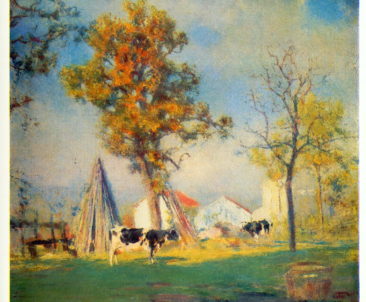
Ivan Pavlovich Pokhitonov – Russian artist, landscape master. Member of the Association of Wanderers.
The artist was born in the village of Matrenovka, Kherson province, in a family of hereditary military men. Since childhood, I.P. Pokhitonov was fond of drawing, painted Ukrainian huts, Kherson steppes, his relatives and friends in watercolor and oil. Later peered into the painting of the Wanderers and the French “Barbizon”.
Pokhitonov did not receive special education. He had to learn all the secrets of the painter’s skill on his own.
In the autumn of 1876, at the Traveling Exhibition held in Elizavetgrad, Pokhitonov first became acquainted with the paintings of A.I. Kuindzhi, I.I. Shishkina, A.P. Bogolyubova, A.K. Savrasova, M.K. Klodt, N.N. Ge, I.N. Kramskoy, V.E. Makovsky, who made a huge impression on him. The dream of becoming a participant in such an exhibition one day determined all his further aspirations to achieve professionalism. He decided to study in Paris.
To improve mastery at the end of 1876, the artist traveled to Italy, and in 1877 settled in Paris. The following year, his landscapes were taken to the exhibition of the Champs Elysees, in which participation testified to the international recognition of the artist.
Constructiveness, a free pictorial manner, amazing fidelity and clarity of tonal and color relations made him the most French among Russian landscape painters. It was not by chance that Ilya Repin gave Pokhitonov the exact definition of “wizard-artist”.
The French, however, admired the harmony and clarity of its landscapes, the ability to convey to an illusion the subject form, the virtuoso technique thanks to which the artist managed to combine the direct perception of nature with the technique of miniature painting.
Ivan Pokhitonov created his miniatures on small plates of red or lemon wood, using a magnifying glass. He painted with thin brushes; he achieved surface smoothness by polishing with fish bone. Most often, the author created landscapes, but in addition he also worked on portraits, still lifes and genre scenes.
It so happened that in the homeland Pokhitonov did not have such success as abroad. However, the artist’s work was highly appreciated by V.A. Serov, V.M. Vasnetsov, K.A. Savitsky, V.D. Polenov, I.N. Kramskoy. In 1904, Pokhitonov became a full member of the Academy of Arts.
At different times, the artist lived in Paris, in the suburbs of the Belgian town of Liege. From 1913 to 1917 he lived in Russia, in St. Petersburg and the Kuban, then again left for Belgium.
Pokhitonov died on December 12, 1923 in Brussels.
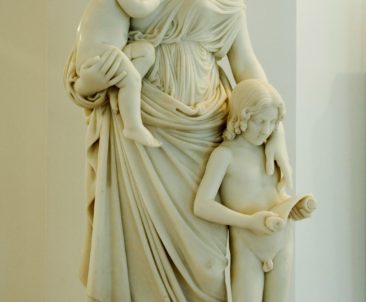
Lorenzo Bartolini is an Italian sculptor. He was born in Tuscany. Since childhood, fond of sculpture, and already at the age of 20 had a lot of experience in working with alabaster. In 1797, Lorenzo went to Paris, where his teacher became F. Lemo, and six years later the master received the Academy Award for the composition “Cleobis and Beaton”.
Thanks to this success Bartolini received many orders from the director of the Louvre Dominique Denon. The master also executed the bust of Napoleon, who satisfied the crowned customer so much that he ordered to open for the sculptor a school of sculptors in Carrara. With the fall of Napoleon, Bartolini moved to Florence and stayed there forever.
The works of Lorenzo at one time met all the requirements of realism, his work was very popular. According to the estimate of the beginning of the 20th century, reflected in the Britannica encyclopaedia: Lorenzo Bartolini is the most significant Italian sculptor since the time of Antonio Canova.
His most famous work is the sculpture “Faith in God”, one of the copies of which is in the Hermitage.
In the exposition of the VOKHM. I.N. Kramskoy presented a copy of the sculpture of Lorenzo Bartolini “Mercy”.
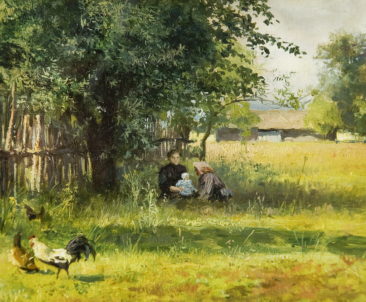
Initially, Mikhail Konstantinovich, he entered the mountain cadet corps, but he did not like studying Mikhail, and he often missed classes. Only the drawing classes, which Ivan Fomich Khrutsky led in the corps, caused him satisfaction. His teacher also saw in his student future talent.
In 1851, 18-year-old Mikhail Klodt enrolled in the Imperial Academy of Arts, where he was enthusiastically trained in the class of M.N. Vorobyov, who taught landscape painting. In 1853, for one of his student works, he was awarded a silver medal of the second degree and became a fellowship of the Society for the Encouragement of Artists. In 1855 he was awarded a large silver medal, and in 1857 for the painting “View on Valaam Island” written in 1854 he was awarded a small gold medal, and the canvas was exhibited at an academic exhibition in 1857 and received good critical reviews. After graduating from the Academy of Fine Arts in 1858, he received the title of first-degree artist and was awarded a large gold medal.
Mikhail Klodt successfully took place as an artist who had his own view of art and recognizable handwriting. His works are characterized by realism of the image, irreproachable drawing with scrupulous elaboration of details, mastery of perspective solutions, strictness and harmony of composition, ability to “inspire” nature with the presence of a person. For him, there is an inherent thoroughness in the drawing of foreground objects and generality in distant plans and the sky with clouds. This accuracy in writing small details required a lot of effort and a lot of time to create a canvas. Achieving high accuracy, the artist sometimes had to rewrite the picture several times.
Almost nothing is known about the last years of the artist’s life. Mikhail Konstantinovich Klodt passed away on May 29, 1902.
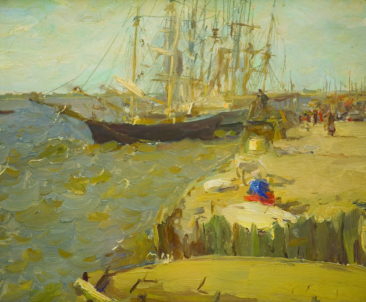
Valentin Aleksandrovich Serov is a famous Russian painter, graphic artist and portrait master. He was born in a creative family, his father was a famous composer and music figure, and his mother – a pianist and the creator of several operas. The future artist lost his father early, and his mother raising his son, in every possible way encouraged his craving for drawing from childhood.
Childhood Valentin Serov spent in Munich, where he learned the basics of drawing with the German artist Keppingom, later the family moved to Paris, where he met IE. Repin, who later became his teacher and after returning to Moscow, introduced Serov to the circle of the most famous artists.
Serov studied at the Academy of Arts under the leadership of the famous professor and teacher P.P. Chistyakov. At the age of 22, the artist created his famous work “Girl with Peaches”, which immediately glorified him.
In the 1890s, Valentin Serov was carried away by writing portraits, even created several canvases depicting members of the royal family. The artist himself brought up six children together with his wife.
Painting of the master strikes amazing freshness and jewelry development of every millimeter on canvas, his works of art have gained worldwide fame, glorifying the paintings of Russian artists.
More than ten years Serov was engaged in teaching at the Moscow School of Painting, Sculpture and Architecture, acting as a master and a guide for young people. But, unfortunately, due to the sudden death, I could not realize all my ideas and plans.
In the exposition of the VOKHM. I.N. Kramskoy presented his painting “The Archangel Port”.
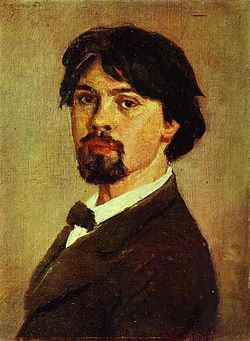
Surikov Vasily Ivanovich – an outstanding master of Russian fine art of the XIX and early XX century. His work is closely connected with the vivid periods of the history of Russia, in his large-scale works the artist truthfully conveyed the characteristic signs of the Russian people, his originality and vital essence.
Vasily Surikov was born in the city of Krasnoyarsk in a poor Cossack family and was very close to his people. From early childhood, the artist showed the beginnings of a talent for drawing. He studied art in his native city in a parish school. Later moved to St. Petersburg to study at the Academy of Arts, where his mentor was P.P. Chistyakov.
In his paintings, the artist portrayed critical, critical moments in Russian history, real historical figures and generalized-typified (but at the same time endowed with bright, individual characters) images of Russian people of different estates. Special emotional sharpness gives to Surikov’s paintings a social or personal conflict, embedded in the thematic basis of the works. In the process of working on large paintings, jealously picking the nature, Vasily Surikov wrote wonderful portraits, landscapes, still-life and interior compositions that have a completely self-esteemed aesthetic meaning. The artist’s paintings are very remarkable for their magnificent coloristic interpretation of the letter, where there is an obvious innovation of the artist in the creation of colorful paintings, the colorful composition of which is studied today by contemporary artists.
He created a number of independent portraits, simple in composition, but strong and holistic in the colorful modeling.
Image: Surikov V.I. Boyarynya Morozova. (State Tretyakov Gallery).
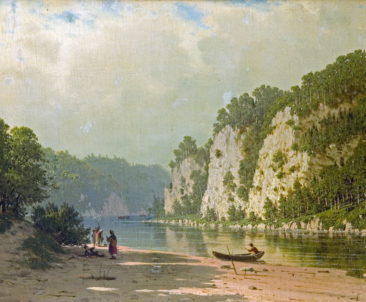
On January 26, Petr Petrovich Vereshchagin was born in Perm. He is a Russian artist, an academician of landscape painting, who went down in history as the first landscape painter of the Middle Urals. Together with younger brothers (one of whom is a painter and portraitist Vasily Vereshchagin) studied pictorial crafts. The first teacher was their father – Peter Prokofievich Vereshchagin.
Peter and Vasily continued their education in the Imperial Academy of Arts. However, for their artistic interests, the brothers differed noticeably. Peter chose his specialty landscape painting. One of his teachers was S.M. Vorobiev – a famous landscape painter, who lived in Italy for many years. His lessons had a strong influence on the young man.
Peter Vereshchagin graduated from the Academy of Arts in 1865 with the title of a class artist of the third degree for his painting “View in Nizhny Novgorod”.
After graduating from the Academy he worked as a teacher and created many landscapes. His kinds of cities or their characteristic places brought him and official recognition, expressed in awarding the titles of the artist second and then first degree, the academician of landscape painting in 1873 and famous among art lovers.
After leaving the pedagogical work, the artist traveled a lot and wrote a lot: views of the Caucasus, the Crimea, the Urals, and the North-West of Russia.
During the Russo-Turkish War of 1877-1878 he was in the army and created a number of paintings, without changing, however, his inclinations, mainly landscapes associated with the image of the Danube.
Petr Vereshchagin is one of those artists who tried, above all, to create an ideal and, therefore, a beautiful image of nature and the city, while observing the accuracy of the depicted.
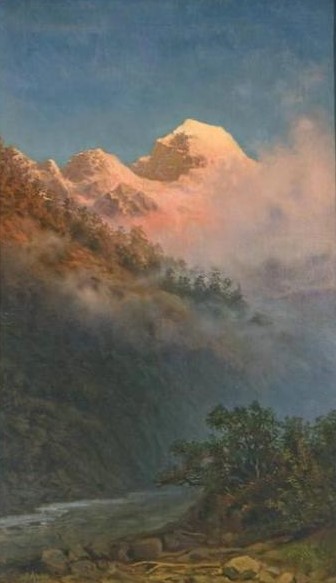
Arkhip Ivanovich Kuindzhi was born on the outskirts of Mariupol in the Greek family, a poor shoemaker. The name of Kuinji was given to him by the nickname of his grandfather, which means “goldsmith”. Early orphaned, the boy lived with relatives, worked with strangers: he was a servant at a grain seller, served with a contractor, worked as a retoucher with a photographer.
His love for painting was manifested in his childhood, he drew everywhere he had – on the walls of houses, fences, scraps of paper. Passion for drawing led him to Feodosia to IK. Aivazovsky. After spending several months with the famous artist, Kuindzhi went to Petersburg with a dream to enter the Academy of Arts. Due to poor artistic preparation, it was not possible to become a student of the Academy at once. He twice held exams and both times to no avail. But this could not stop a stubborn and persistent young man, and in 1868, with the rank of a non-class artist, he was admitted to the Academy as a volunteer.
The paintings created by the artist in the period from 1872 to 1876 were close to the paintings of the Peredvizhniki artists. During this time the following works were created: “Autumn mudslide”, “Lake Ladoga”, “On the island of Valaam”, “Forgotten village”, “Chumatsky tract in Mariupol”, “Steppe in bloom” and “Steppe in the evening”.
In 1876 Arkhip Kuindzhi showed the picture “Ukrainian Night”, in which he managed to convey the sensual perception of the southern summer night, with an unprecedented courage for his time generalizing color and simplifying the form. In order to so naturally and expressively convey the moonlight, the flickering of stars, the artist had to solve the most complicated pictorial tasks. In the picture, everything is built on the virtuoso development of tonal relations, on the richness of color combinations. In 1878, the picture was presented at the World Exhibition in Paris.
The painting became a sensational event of artistic life, and followed by others, not inferior to it in defiant decorative: “Birch Grove”, “Moonlit Night on the Dnieper”, “Dnepr Morning” and others. “Moonlit Night on the Dnieper” was demonstrated in 1880 in St. Petersburg. At the entrance to the exhibition one picture was a huge queue. The work caused a storm of ecstasy. In the following year, 1881, Kuindzhi just showed a new version of “Birch Grove”, and a year later – three more paintings.
Kuindzhi’s skill in the transmission of light is the result of the artist’s immense work, of long searches. His workshop was the laboratory of the researcher. He experimented a lot, studied the laws of the action of additional colors, looking for the right tone, checked it with color relations in nature itself. With persistent, persistent work, Kuindzhi achieved masterly mastery of color, the compositional simplicity that distinguishes his best works.
The exhibition of 1882 was the last for the artist. At the zenith of fame, Kuindzhi made a new unexpected step: he stopped exhibiting his works altogether. Long years of silence followed. But Kuindzhi continued to work hard, showing what was done only to close people.
In 1909, Arkhip Kuindzhi organized the Kuindzhi Society to support artists, who bequeathed all his paintings and money.
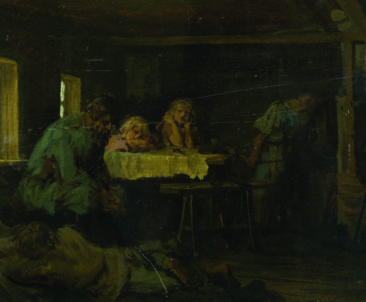
Vasily Maksimov was born into a family of state peasants, and up to ten years he grew up in the countryside. Like most Russian artists, the range of his early artistic impressions became decisive. Maximov was surrounded by centuries-old way of life of peasants, colorful ceremonies of weddings and agricultural holidays, huts with beautiful carvings, costumes, household fabrics, embroideries on them. The boy woke up early poetic sensitivity and the ability to see beauty.
In six years, Vasily survived the death of his father, and at ten – the death of his mother. Mother managed to identify her son in the monastery school, and then to the novices of the Nikolayev Monastery, from which he left autocratically, went to Petersburg and entered the iconographic studio of Poshekhonov. Faced with unprecedented cruelty in dealing with students, he escaped from this workshop to the icon painter KA Yarygin, where he lived for five years. The boy lived a dream to study at the Academy of Arts. To earn money for clothes, he managed to write icons and portraits of local small merchants. To survive in such conditions and not get lost, Maximov needed to have great perseverance and inner aspiration.
In the autumn of 1862, Maximov passed the entrance examinations to the Academy of Arts, in 1863, as an auditor (since he had no leave from the rural society), he began his studies at the Academy. Maximov began his studies with reverence and ecstasy. For him, the time of rapid success began. In continuation of the entire training, among the talented fellow practitioners, among whom were Savitsky, Polenov and Repin, Maximov was one of the very first.
In the spring of 1864 in St. Petersburg, young Maximov entered the Artel of Artists, headed by P.A. Crusader. Young artists of the early 1860s, mastering the aesthetics of the revolutionary democrats, first turned to the reproduction of Russian life, to the search for beauty in real life. The young generation of painters, in an atmosphere of general democratic upheaval, was imbued with civic ideals, assured of their social and moral vocation. Maximov was a direct witness of all these events.
At the end of the Academy with the title of artist of the third degree Vasily Maksimov settled in his native village. He lived in a hut, wore a Russian shirt and trousers. Peasants took Maximov, he became for them his. The authority of the artist was so great that the peasants went to him for advice, he was invited to the family sections, with many peasants he corresponded for many years. Life in the countryside and the writing of peasant paintings became a real asceticism of a deeply convinced and strong spirit of the artist.
Image: В.М. Maksimov. Meager lunch. 1870’s. (from the collection of the VKHM named after I. Kramskoy).
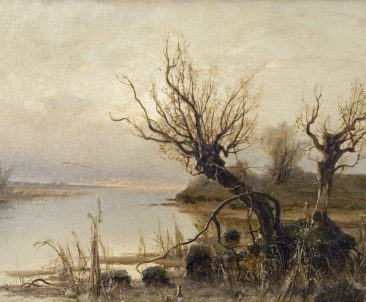
Julius Yulevich Klever (at the birth of Julius) came from the German Baltic clan von Klever; his father was a master of chemistry and taught at the Veterinary Institute in Dorpat.
Since childhood, Julius has been inclined to drawing and in 1867, after graduating from the Derpt Gymnasium, he began to study in the architectural classes of the Imperial Academy of Arts, but soon moved to the landscape class – he studied with SM. Vorobyov, then – at M.K. Klodt.
In 1874, at the stands of the Society for the Encouragement of Arts, the artist organized his personal exhibition. In 1875 for the painting “Running Park” Julius Klever received a prize from the Society for the Encouragement of Arts, and in 1876 – for the painting “The First Snow on a Plowed Field”. After the second solo exhibition in 1876 his painting “Birch Forest” wished to acquire Alexander II. Julia Klever was awarded the title of class artist of the first degree, and in 1878 for the painting “Old Park” (“View of the neglected park in Marienburg”) he received the title of academician of painting.
Klever did not strive for the accuracy of the image and freely sacrificed it for the sake of expressiveness of the picture as a whole. He willingly wrote autumn and winter with their harsh and sharp decorative effects. Unlike landscape painters of his epoch (except AI Kuindzhi), he appreciated the expressiveness of the underlined spot, silhouette, contour: they often played a big role in his paintings. Contemporaries Klever, his admirers, argued that the artist writes a new, bold, original, and his works are forced to love the fatherland more strongly.
And in the 1890s, events took place, as a result of which J. Klever left for Germany: he was attracted as a witness to the high-profile case of financial abuse of his friend, former conference secretary of the Academy of Fine Arts P.F. Iseyeva.
In Germany, J. Klever lived for seven years. After returning to his homeland in 1915, Julius Yulievich arranged an exhibition in Moscow, made creative trips to the Baltic states, Finland, Belarus, Smolensk province. However, despite the change in the world outlook, Klever remained true to himself. The artist retained his “original clover” handwriting, for which his works were bought, collected, published in newspapers and magazines, on postcards, and for which his works were forged. Klever’s “effects” gave the artist a bright personality, originality and recognition.
After the revolution of 1917 Yu.Yu. Klever received material support from the Society of Artists. A.I. Kuindzhi. Until the end of his life he taught at the Academy of Fine Arts and at the Central School of Technical Drawing. Optimism, love of life helped Yulia Yulievich to live to a very old age. He philosophically perceived the turbulent Russian events, he remembered the past days with a smile.
The artist’s works are kept in the State Russian Museum, the State Tretyakov Gallery, the Serpukhov Historical and Art Museum, the museums of Barnaul, Vladimir, Volgograd, Kaluga, Kozmodemyansk, Kostroma, Krasnodar, Lipetsk, Veliky Novgorod, Sevastopol, Semey, Serpukhov, Stavropol, Syktyvkar, Tambov, Ulyanovsk, Alma-Ata, Yerevan; in private collections.
Image: Yu.Yu. Klever. Snow in the forest. 1885 (from the collection of VNKhM named after INKramskoy).